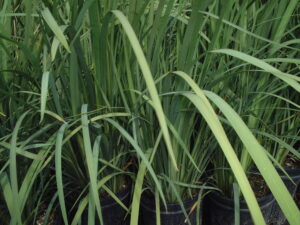S & J Nurserys Guide to Growing
Yellow African Iris
in the Northeast Florida Landscape
( Dietes bicolor )
Yellow African Iris Origins:
– These striking perennial plants are native to Africa and are considered to be a ‘Florida Friendly’ landscape selection.
– Although not technically an Iris at all they are known here in the North
Florida area landscapes as African Iris. But also may be found under the names Morea Lily, Fortnight Lily, Butterfly Iris etc. Regardless of what name you choose to call them by, here in North Florida we love them!
Dietes Bicolor Preferred Exposure:
– African Iris can be planted in full sun to full shade in just about any type of garden you can think of.
Yellow African Iris Foliage:
– Lighter green thinner than typical of the species, sword-like foliage
stands mostly erect then tapers outwards and down towards the top of the plant forming an almost fountain-like appearance, clusters of foliage form large clumps and makes a dramatic vertical statement in the garden or
landscape.
Dietes Bicolor Soil Preference / Salt tolerance:
– African Iris is tolerant of a wide range of soil components and growing
conditions. Although moderately drought tolerant once established in the landscape be sure to water regularly after planting to help get the plant established and growing on its own in the landscape.
– Yellow African Iris will tolerate wet soils for prolonged periods like the
White African Iris.
– When planted in full sun in well drianed soils plants may need supplemental irrigation to perform at their best
– Poor salt tolerance.
Yellow African Iris Size Variance:
– Foliage of the Yellow African Iris can grow up to 2-4 ft High and 3-4 ft
wide although most often seen rowing at heights of 2-3 feet. ( taller when planted in constantly wet areas or used as an aquatic plant)
Yellow African Iris Growth Habit:
– Evergreen, clumping perennial has a mostly erect yet almost fountain like
appearance.
– Plants should be dug and divided every 2 – 5 years in early spring for best
results. Divisions make great transplants for adding more beautiful easy maintenance blooms back into the landscape!
Dietes Bicolor Growth Rate:
– yellow African Iris is a moderate to fast growing perennial plant.
Yellow African Iris / Morea Lily / Fortnight Lily / Butterfly Iris Bloom:
– Beautiful pale or buttery yellow blooms are reminiscent of an
orchid flower and have a brownish or deep burgundy splotch towards the base of the petals.
-The blooms are approximately 2 inches across in diameter and plants put out blooms continuously throughout the year, although strongest flowering will occur in spring and again in summer.
– The flower stalks of the Yellow African Iris last only one season,
so unlike those of the white African Iris they can be trimmed off when they have gone completely brown or have started to form the 2 inch elongated green seed capsules.
Dietes Bicolor Water Requirements:
– Yellow African Iris plants although moderately drought tolerant once established in the landscape, will require regular water to get the plant rooted and growing on its own after being planted in the ground from an S & J nursery container. Use supplemental irrigation when planted in full sun or in extremely sandy soils for best flowering.
– Can be used as an aquatic plant for water gardens.
Butterfly or Bird Attracting:
– Yellow African Iris blooms are not said to attract hummingbirds or butterfly’s to your garden.
Best Uses For Yellow African Iris Plants in the North Florida | Jacksonville | St.
Augustine area Landscape:
– African Iris plants are at home in any garden from a strong Mediterranean garden theme to a cottage garden setting plants blend perfectly.
– African Iris make excellent potted plants and their strongly erect foliage adds a dramatic flare to any garden setting. I love to see them near patios, pools or walkways where the gorgeous blossoms can be appreciated up close.
– Perfect in masses under larger trees or landscape specimen plant you want to draw attention to. Massed plantings of African Iris will instantly turn a drab tucked away corner of the yard into a landscape showpiece.
– Low maintenance landscape selection.
– Fire resistant
Care of Yellow African Iris plants:
– Water every day during the establishment period after planting in the garden from an S & J Nursery container.
– When planted in full sun or well drained sandy soils, supplemental irrigation is preferred for maximum flowering.
– As with all perennial plantings, amending the soil with compost when planting your African Iris plants will help keep them healthy and happy through the years.
– Plants should be dug and divided every 2-5 years in the early spring.
– Fertilize each spring with a handful of garden compost or a mixture of Milorganite or Green Edge Fertilizer and a slow release poly coated plant food such as Osmocote or Stay Green general purpose plant food or 10-10-10.


